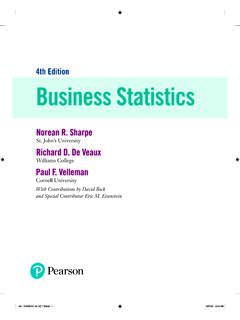Transcription of SEVENTH EDITION PROBLEM SOLVING AND
1 SEVENTH EDITION . PROBLEM SOLVING AND. PROGRAM DESIGN. C. in This page intentionally left blank SEVENTH EDITION . PROBLEM SOLVING AND. PROGRAM DESIGN. C. in Jeri R. Hanly, university of Wyoming Elliot B. Koffman, temple university Boston Columbus Indianapolis New York San Francisco Upper Saddle River Amsterdam Cape Town Dubai London Madrid Milan Munich Paris Montreal Toronto Delhi Mexico City Sao Paulo Sydney Hong Kong Seoul Singapore Taipei Tokyo Editorial Director, ECS: Marcia Horton Creative Director: Jayne Conte Editor-in-Chief: Michael Hirsch Designer: Suzanne Behnke Senior Project Manager: Carole Snyder Media Editor: Daniel Sandin Director of Marketing: Patrice Jones Media Project Manager: John Cassar Marketing Manager: Yezan Alayan Cover Image: (c) michael Senior Marketing Coordinator: Kathryn Ferranti Full-Service Project Management: Mohinder Singh/.
2 Director of Production: Vince O'Brien Aptara , Inc. Managing Editor: Jeff Holcomb Composition: Aptara , Inc. Associate Managing Editor: Robert Engelhardt Printer/Binder: Edwards Brothers Production Manager: Pat Brown Cover Printer: Lehigh-Phoenix Credits and acknowledgments borrowed from other sources and reproduced, with permission, in this textbook appear on appropriate page within text. Photo Credits: Page 4: Fig. : akg-images/Paul Almasy/Newscom. Page 11: Fig. : 2008 IEEE/Journal of Microelectromechanical Systems (2006). Page 15: Fig. : Intel Corporation Pressroom Photo Archives. Page 16: Fig. (a) Hugh Threlfall/Alamy; Fig. (b) Hewlett-Packard Company; Fig. (c) D. Hurst/Alamy; Fig. (d). Handout/MCT/Newscom. Microsoft and Windows are registered trademarks of the Microsoft Corporation in the and other countries. Screen shots and icons reprinted with permission from the Microsoft Corporation.
3 This book is not sponsored or endorsed by or affiliated with the Microsoft Corporation. Copyright 2013, 2010, 2007, 2004, and 2002 Pearson Education, Inc., publishing as Addison-Wesley. All rights reserved. Printed in the United States of America. This publication is protected by Copyright, and permis- sion should be obtained from the publisher prior to any prohibited reproduction, storage in a retrieval system, or transmission in any form or by any means, electronic, mechanical, photocopying, recording, or likewise. To obtain permission(s) to use material from this work, please submit a written request to Pearson Education, Inc., Permissions Department, One Lake Street, Upper Saddle River, New Jersey 07458, or you may fax your request to 201-236-3290. Many of the designations by manufacturers and sellers to distinguish their products are claimed as trademarks.
4 Where those designations appear in this book, and the publisher was aware of a trademark claim, the designations have been printed in initial caps or all caps. Library of Congress Cataloging-in-Publication Data Hanly, Jeri R. PROBLEM SOLVING and program design in C / Jeri R. Hanly, Elliot B. Koffman. 7th ed. p. cm. ISBN-13: 978-0-13-293649-1. ISBN-10: 0-13-293649-6. 1. C (Computer program language) I. Koffman, Elliot B. II. Title. 2013. 3 dc23 2012000375. 10 9 8 7 6 5 4 3 2 1. ISBN 10: 0-13-293649-6. ISBN 13: 978-0-13-293649-1. This book is dedicated to Jeri Hanly's family: Brian, Kevin, Laura, Trinity, and Alex Eric, Jennifier, Mical, Micah, Josiah, and Rachel Elliot Koffman's family: Caryn and Deborah Richard, Jacquie, and Dustin Robin, Jeffrey, Jonathan, and Eliana This page intentionally left blank PREFACE. PROBLEM SOLVING and Program Design in C teaches a disciplined approach to prob- lem SOLVING , applying widely accepted software engineering methods to design program solutions as cohesive, readable, reusable modules.
5 We present as an implementation vehicle for these modules a subset of ANSI C a standardized, industrial-strength programming language known for its power and portability. This text can be used for a first course in programming methods: It assumes no prior knowledge of computers or programming. The text's broad selection of case studies and exercises allows an instructor to design an introductory programming course in C for computer science majors or for students from a wide range of other disciplines. New to this EDITION Several changes to this EDITION are listed below: Chapters 3 (Functions), 5 (Loops), and 7 (Arrays) include optional sections on graphics programming Chapter 6 (Pointers and Modular Programming) includes a new section on pointers New complete programs show use of if statements in Chapter 4. New complete program shows use of switch statement in Chapter 4.
6 Chapter 7 (Simple Data Types) in previous EDITION is eliminated and its contents integrated into other chapters of the book Hardware examples in Chapter 1 are updated to reflect current technology Several chapters contain new programming project homework problems More About Graphics Many Computer Science faculty have recommended the use of graphics to help motivate the study of introductory programming and as a vehicle to help students understand how to use libraries and to call functions. We agree with this viewpoint and have included three optional sections with graphics examples in this EDITION . The new graphics sections include: Section : Introduction to Computer Graphics Section : Loops in Graphics programs Section : Graphics programs with Arrays To reduce the overhead required to introduce graphics, we decided to use WinBGIm (Windows BGI with mouse), which is a package based on the Turbo viii Preface FIGURE 1.
7 Pascal BGI (Borland Graphics Interface) library. WinBGIm was created to run on top of the Win32 library by Michael Main and his students at the university of Colorado. Several development platforms appropriate for CS 1 courses have incor- porated WinBGIm. Quincy (developed by Al Stevens) is an open-source student- oriented C++ IDE that includes WinBGIm as well as more advanced libraries ( ). Figure 1 shows the Quincy new project window (File New Project) with WinBGIm Graphics application selected. A command-line platform based on the open-source GNU g++ compiler and the emacs program editor is distributed by the university of Colorado (http://www. ). WinBGIm is also available for Bloodshed Software's Dev-C++ and Microsoft's Visual Studio C++. Using C to Teach Program Development Two of our goals teaching program design and teaching C may be seen by some as contradictory.
8 C is widely perceived as a language to be tackled only after one has learned the fundamentals of programming in some other, friendlier language. The Preface ix perception that C is excessively difficult is traceable to the history of the language. Designed as a vehicle for programming the UNIX operating system, C found its original clientele among programmers who understood the complexities of the oper- ating system and the underlying machine and who considered it natural to exploit this knowledge in their programs . Therefore, it is not surprising that many textbooks whose primary goal is to teach C expose the student to program examples requir- ing an understanding of machine concepts that are not in the syllabus of a standard introductory programming course. In this text, we are able to teach both a rational approach to program devel- opment and an introduction to ANSI C because we have chosen the first goal as our primary one.
9 One might fear that this choice would lead to a watered-down treatment of ANSI C. On the contrary, we find that the blended presentation of programming concepts and of the implementation of these concepts in C captures a focused picture of the power of ANSI C as a high-level programming language, a picture that is often blurred in texts whose foremost objective is the coverage of all of ANSI C. Even following this approach of giving program design precedence over discussion of C language features, we have arrived at coverage of the essential constructs of C that is quite comprehensive. Pointers and the Organization of the Book The order in which C language topics are presented is dictated by our view of the needs of the beginning programmer rather than by the structure of the C programming language. The reader may be surprised to discover that there is no chapter entitled Pointers.
10 This missing chapter title follows from our treatment of C as a high-level language, not from an absence of awareness of the critical role of pointers in C. Whereas other high-level languages have separate language constructs for out- put parameters and arrays, C openly folds these concepts into its notion of a pointer, drastically increasing the complexity of learning the language. We simplify the learning process by discussing pointers from these separate perspectives where such topics normally arise when teaching other programming languages, thus, allowing a student to absorb the intricacies of pointer usage a little at a time. Our approach makes possible the presentation of fundamental concepts using traditional high- level language terminology output parameter, array, array subscript, string and makes it easier for students without prior assembly language background to master the many facets of pointer usage.




![John Steinbeck - The Pearl [EnglishOnlineClub.com]](/cache/preview/a/6/7/2/0/1/4/a/thumb-a672014a0e7c6d32ccce67a6d17482be.jpg)







